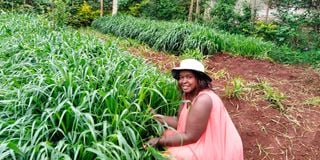Cows just have a liking for super Napier grass

Anne Wangechi, a dairy farmer at the plot she’s grown brachiaria grass. Super Napier grass has an impressive 20.5 per cent crude protein and nine Mega Joules of energy.
Sometime back, I planted brachiaria grass to improve fodder for my cattle. The grass did well and the animals loved it. I have said in this column before that my experience with brachiaria on farms visited has been good.
On one farm in Murang’a County, weaner heifer calves had bounced back to their growth curve after brachiaria ration was increased in their feed.
The calves had lost body condition badly after weaning.
Body condition loss is a common challenge of calf rearing because of the sudden withdrawal of milk that is rich in proteins and energy.
To avoid the heavy dip in growth and body condition, a farmer should ensure the energy and protein lost from milk withdrawal is replaced by the post weaning feed.
Brachiaria grass is a good feed component for weaner heifers because of its high protein content. Research shows the grass ranges in crude protein content from five to 20 per cent, depending on the strain of the grass, how it is cultivated and the stage of growth at which it is harvested.
A farmer should, therefore, select the brachiaria strains with high protein content and understand the stage at which protein content and volume of herbage is highest.
Farmers should also form the good practice of carrying out periodic laboratory analyses of the nutritional content of their fodder crops to inform their decision on formulating feeds.
With the reduction of land sizes and the high cost of feed inputs, the days of farming just to produce milk and meat without minding the economics of production are fast running out.
While my brachiaria was establishing well, I found its yield low especially during dry times.
I dropped the brachiaria quest altogether last year when I investigated heavily on the viability of using super Napier.
I spent sometime working to understand the crop against the many claims that were made by its promoters.
My search came to an end when I visited a farm that was aggressively adopting the crop in Murang’a.
I visited the farm with a friend, with whom we are members in a WhatsApp forum called “Lead Farmer”. I had been looking for a farmer’s testimony and tangible evidence of the vigour and utility of super Napier as a nutritious, palatable and high-volume fodder crop.
I was impressed by the trust and faith the farm we visited had on super Napier. They had planted a small experimental lot of the grass where they had uprooted the previously widely used Napier grass.
The super Napier crop was introduced on the farm in May 2022 but when I visited, they were harvesting the second crop and had already expanded to four acres.
The manager said the farm had cut on the cost of feeding by about 20 per cent with the introduction of super Napier.
The health of the cows and production had also greatly improved, according to her records and my observation.
As a scientist, it was obvious, from my findings on the farm, that there was a lot of good in the super Napier. It was not just hype. I made the decision to plant the crop for my cows.
As a practical scientist, I try to pass production and animal health knowledge to users from verifiable sources, quality published findings or personal experiences validated by science.
I started planting my super Napier in January and made the first harvest nine weeks later.
The planting instructions were clear. In addition, they anticipated the rapid growth and heavy multiplication of the Napier.
We planted two-node cuttings in holes of two cubic feet, meaning two feet long, wide and deep.
The holes were spaced three feet and the lines three feet too.
The planting can, therefore, be summarised as two by two by two feet holes, three by three feet apart.
We used about 10kg of ruminant manure for every hole. From the planting instructions, the manure was said to be sufficient to keep the Napier nourished until the second harvest when it would require more.
I am yet to see that practically but some of my first harvest Napier showed poor growth when shooting again.
I corrected the problem by applying urea 46 per cent fertiliser.
I have been impressed by the high establishment rate of the Napier, vigour with which the shoots emerge, very fast growth rate, high rate of multiplication of the stems and the heavy leaf or herbage yield.
Unless the super Napier grows too tall and old, the lower leaves remain green and suitable for animals.
My cows really like the Napier grass. They even chewed the stems we harvested at nine weeks since planting.
To walk the talk, I took a sample of the Napier grass to the University of Nairobi’s Animal Nutrition Laboratory for analysis.
It yielded 20.5 per cent crude protein but retained the published nine Mega Joules of energy. That was impressive.
The highest analytical results I had seen before was 19 per cent crude protein and about 9MJ from the Crop Nut Laboratory.
The most commonly reported range of crude protein content of super Napier is 16-18 per cent.
The gold standard for fodder protein has been Lucerne with a common range of 18-22 per cent crude protein.
We noticed that when the cows are fed super Napier and brachiaria mixed but not chopped, they preferred super Napier to the brachiaria. This attests to the palatability of the fodder.
Super Napier is a fairly new type of fodder developed in Thailand by crossing Napier grass with pearl millet. It has spread to many parts of the world, especially Asia and Africa.
My continuing adventure with super Napier tells me the plant has the capacity to revolutionise livestock farming.





